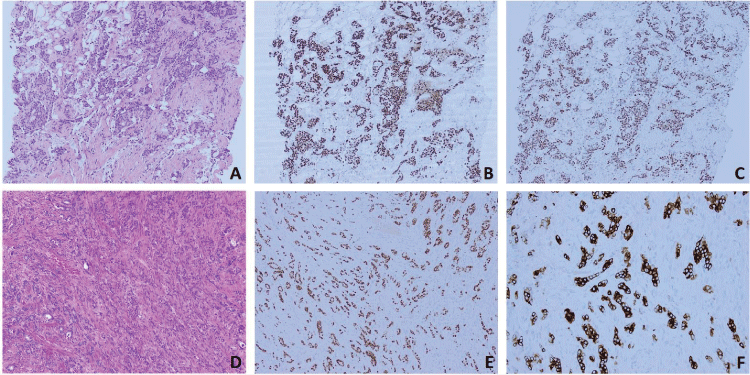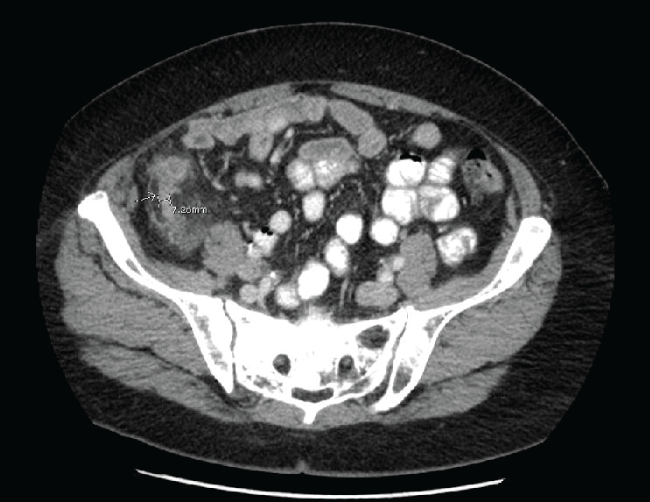International Journal of Cancer and Clinical Research
Appendiceal Metastasis in a Patient with Advanced Breast Cancer on Hormonal Therapy
Edmond Kwan1*, Nezor Houli2, Meron Pitcher2 and Shirley Wong1
1Department of Medical Oncology, Western Health, Sunshine Campus, Australia
2Department of General Surgery, Western Health, Sunshine Campus, Australia
*Corresponding author:
Edmond Kwan, Medical Oncology Registrar, Western Health, Sunshine Campus, 176 Furlong Road, St Albans, VIC, Australia 3021, Tel: +61-3-8345-1333, Fax: +61-3-9005-2730, E-mail: edmond.kwan1@gmail.com
Int J Cancer Clin Res, IJCCR-3-059, (Volume 3, Issue 3), Case Report; ISSN: 2378-3419
Received: April 07, 2016 | Accepted: June 18, 2016 | Published: June 20, 2016
Citation: Kwan E, Houli N, Pitcher M, Wong S (2016) Appendiceal Metastasis in a Patient with Advanced Breast Cancer on Hormonal Therapy. Int J Cancer Clin Res 3:059. 10.23937/2378-3419/3/3/1059
Copyright: © 2016 Kwan E, et al. This is an open-access article distributed under the terms of the Creative Commons Attribution License, which permits unrestricted use, distribution, and reproduction in any medium, provided the original author and source are credited.
Abstract
A 70-year-old woman presented with abdominal pain nine months after the diagnosis of de-novo, hormonal-receptor positive advanced breast cancer. Imaging revealed appendiceal stranding likely representative of acute appendicitis. Surgery was performed, and pathological examination of the inflamed appendix revealed metastatic carcinoma consistent with breast primary. The case highlights the diagnostic challenges of abdominal pain in a patient with advanced cancer. Furthermore, though an uncommon occurrence, appendiceal metastases must be considered in breast cancer patients with abdominal pain, especially given the high rate of subsequent sequelae if left unrecognised and untreated.
Keywords
Breast cancer, Metastatic breast cancer, Acute appendicitis, Hormonal therapy, Invasive ductal carcinoma
Introduction
Abdominal pain is a common complaint in clinical medicine. In patients with active malignancy, accurate diagnosis of the underlying aetiology can often be complicated by additional patient and treatment factors. Advanced age, recent chemotherapy, treatment-related neutropenia and concomitant opioid or steroid use are just some of the potential pitfalls in managing this population group.
Improvements in therapeutic strategies in advanced breast cancer have resulted in longer overall survival. As a result, there may be increased incidence of unusual sites of metastases in this population group. The following is a case of a 70-year-old female with known advanced breast cancer on hormonal therapy, who presented to the emergency department with abdominal pain secondary to appendiceal metastatic disease.
Case Report
A 70-year-old female presented to a metropolitan emergency department with a two-day history of right iliac fossa pain, nausea and vomiting but without subjective fevers. She had been diagnosed with de-novo advanced breast cancer approximately nine months prior, after presenting with pathological rib fractures. Biopsy of a palpable right-sided breast mass at the time revealed a Grade 2 invasive ductal carcinoma (IDC), strongly oestrogen receptor-positive (ER 3+, 80-90%), moderately progesterone receptor-positive (PR 2+, 80-90%) and HER2/neu-negative (additionally non-amplified on dual in-situ hybridisation or DISH) (Figure 1). Systemic staging revealed widespread axial spine and appendicular skeletal metastases, with low volume disease also found in the liver. Baseline CA15-3 was 840 U/ml (N < 40). She was commenced on the aromatase inhibitor anastrozole 1 mg daily, in combination with bone-directed therapy in the form of subcutaneous injections of denosumab 120 mg monthly. She was also administered oxycodone/naloxone (30/15 mg) twice daily and extended-release naproxen (750 mg) once daily for bony pain. This resulted in initial partial response in the size and number of liver metastases, sclerosis of bone metastases, and a dramatic fall in CA 15-3, to the level of 98 U/ml immediately prior to this presentation with abdominal pain.

.
Figure 1: Top Row: Core needle biopsy of right breast mass. (A) Invasive ductal carcinoma (10×); B) Strong oestrogen receptor-positivity (10×); C) Moderate progesterone-positivity (10×).
Bottom Row: Operative appendectomy specimen. (D) Appendix wall with evidence of invasive carcinoma and associated inflammatory cell infiltrate (10×); E) Moderate oestrogen receptor-positivity (10×); F): Strong CK 7 positivity (20×).
View Figure 1
Her initial examination in the Emergency Department revealed a temperature of 36.9°C, a blood pressure of 180/80 mmHg, heart rate of 93 beats per minute, and a respiratory rate of 16 breaths per minute. Her abdomen was tender in the right iliac fossa, without exhibiting any signs of overt peritonism or palpable masses. Bowel sounds were present. The reminder of the examination was unremarkable.
Laboratory tests revealed a mild leucocytosis of 12.4 × 109/L (N 4.0-11.0) with a predominant neutrophilia of 9.2 × 109/L (N 2.0-8.0). Renal and liver function tests were normal. C-reactive protein was elevated at 24 mg/L (N < 10). Subsequent microscopy and culture of a mid-stream urine specimen revealed no growth. An emergency computed tomography (CT) scan of the abdomen revealed a 7.26 mm appendix in the centre of an area of caecal stranding (Figure 2). There was no periappendiceal collection or free gas. Within the confines of the targeted imaging, there was no change in bony metastatic disease burden. Of note, a colonoscopy three weeks' prior (performed as part of follow-up after a recent episode of acute diverticulitis) only revealed the finding of ascending diverticular disease, with a normal appendiceal orifice.

.
Figure 2: Computed Tomography (CT) image of the abdomen revealing a 7.26 mm appendix in an area of caecal stranding, consistent with acute appendicitis.
View Figure 2
The patient was taken to the operating room where an inflamed appendix with adjacent caecal fibrin adhesions was found, without any surrounding collection. There was no gross evidence of disease elsewhere in the abdominal cavity, including the peritoneal and omental surfaces. An uncomplicated laparoscopic appendectomy was performed. Peritoneal washings were not performed. The patient tolerated the procedure well, and was discharged the following day with resolution of symptoms, and an eventual uncomplicated post-operative course.
Pathological examination revealed subacute appendicitis, manifested by infiltration of typical chronic inflammatory cell components, as well as minimal eosinophilic infiltrate. Several sections of the specimen demonstrated infiltrative carcinoma, with extension from the serosal surface towards the muscularis propria. The resection margin was involved with carcinoma. Immunohistochemistry demonstrated strong staining for cytokeratin-7 (CK7) and ER (Figure 1), and negative staining for PR, HER2/neu, chromogranin, synaptophysin and CD56.
In the absence of other objective signs of disease progression intra-operatively and on post-operative restaging imaging, the episode of appendicitis from appendiceal metastasis was not regarded as disease progression. Therapy with anastrozole was continued, however, follow-up frequency has increased given the potential implications of ongoing endocrine therapy in the event of earlier-than-expected disease progression. Nine months after her appendectomy, the patient remains well, tolerating anastrozole with clinically, biochemically and radiologically stable disease.
Discussion
Appendicitis secondary to appendiceal metastasis from primary breast cancer has previously been described in multiple case reports in the literature [1,2]. Whilst it has long been appreciated that invasive lobular carcinomas (ILC) are more likely to metastasise to a gastrointestinal tract (classically stomach and small bowel [3]) and peritoneum-retroperitoneum [4] compared with invasive ductal carcinomas (IDC), the mechanism has been less clear. One possible explanation is the increase frequency of E-cadherin mutations in ILC [5], resulting in lack of expression of this important cell-cell adhesion molecule, and thus potentially compromising the structural integrity of epithelial sheets, a critical step in the pathogenesis of distant metastatic disease [6]. Invasive ductal carcinomas (IDC) typically metastasise to more conventional sites such as bone, lung and liver.
The patient in this case report has breast cancer of ductal subtype. Interestingly, it is worth noting the pathological, molecular change from progesterone-positive disease in the breast primary, to progesterone-negative disease in the appendiceal metastasis. Whilst variable surgical specimen quality or tumour heterogeneity are potential explanations, this may in fact represent tumour de-differentiation from a luminal-A subtype into a more aggressive, poorer prognostic luminal-B subtype of breast cancer.
The presence of concurrent opioid and anti-inflammatory-based analgesia may have also impacted the timely diagnosis and management of this patient, predominantly by masking early symptoms. Other treatment-related factors that contribute to delayed accurate diagnoses of abdominal pain in cancer patients include use of corticosteroids (either intermittent or continuous), as well as cytotoxic therapy, which may predispose to specific conditions, such as neutropenic enterocolitis [7].
Overall, the diagnosis of metastatic breast cancer to the appendix is rare. Nevertheless, appendicitis with or without intestinal obstruction is a potential sequela, with an unusually high rate of subsequent perforation [8,9]. Some groups have even advocated for prophylactic appendectomy at time of oophorectomy or other abdominal surgery in the breast cancer population [7].
This case aims to add to the literature surrounding appendiceal metastases secondary to advanced breast cancer. A recent review highlights the presence of only twelve other such cases, with no obvious trends in histologic subtype, time after cancer diagnosis, and anti-cancer treatment being received at time of event [10].
Conclusion
The workup of abdominal pain in cancer patients represents a unique and challenging situation. Furthermore, the presence of opioid analgesics, immunosuppressive chemotherapy and corticosteroid use, can mask early symptoms and signs of critically important diagnoses. Appendiceal metastases must be considered in breast cancer patients with abdominal pain, especially given the high rate of significant complications with delayed diagnosis and management.
Conflicts of Interest
None.
Written informed consent was obtained from the patient for publication of this case report and the accompanying images.
References
-
Capper RS, Cheek JH (1956) Acute appendicitis secondary to metastatic carcinoma of the breast. AMA Arch Surg 73: 220-223.
-
Latchis KS, Canter JW (1966) Acute appendicitis secondary to metastatic carcinoma. Am J Surg 111: 220-223.
-
Arrangoiz R, Papavasiliou P, Dushkin H, Farma JM (2011) Case report and literature review: metastatic lobular carcinoma of the breast an unusual presentation. Int J Surg Case Rep 2: 301-305.
-
Borst MJ, Ingold JA (1993) Metastatic patterns of invasive lobular versus invasive ductal carcinoma of the breast. Surgery 114: 637-642.
-
Berx G, Cleton-Jansen AM, Strumane K, de Leeuw WJ, Nollet F, et al. (1996) E-cadherin is inactivated in a majority of invasive human lobular breast cancers by truncation mutations throughout its extracellular domain. Oncogene 13: 1919-1925.
-
Robert A Weinberg (2014) The biology of cancer. (2nd edition) Garland Science New York, USA: 207.
-
Maddox PR (1990) Acute appendicitis secondary to metastatic carcinoma of the breast. Br J Clin Pract 44: 376-378.
-
Dirksen JL, Souder MG, Burick AJ (2010) Metastatic breast carcinoma presenting as perforated appendicitis. Breast Care (Basel) 5: 409-410.
-
Philippart P, da Costa PM, Heymans O, Pector JC, de Saint-Aubin N, et al. (2000) Metastatic involvement of ceco-appendicular segment: a diagnosis of right lower quadrant abdominal pain in patient receiving chemotherapy. Hepatogastroenterology 47: 1627-1629.
-
Tahara RK, Keraliya A, Ramaiya NH, Lauren L Ritterhouse, Eric P Winer, et al. (2015) Acute appendicitis secondary to metastatic carcinoma of the breast: Case report and review of the literature. Cancer Treat Commun 4: 41-45.





